The new energy vehicle electric drive systems market is anticipated to grow from USD 4,738.0 million in 2025 to USD 14,847.3 million by 2035, reflecting a CAGR of 12.1%. Analyzing growth in half-decade segments provides insight into periods of accelerated adoption and revenue accumulation. Between 2025 and 2030, the market is expected to generate nearly USD 5,950 million in additional value. This initial phase benefits from increasing adoption of electric vehicles (EVs) across passenger and commercial segments, government incentives, and rising investments in EV infrastructure. Technological improvements in battery efficiency, powertrain performance, and cost reduction drive adoption, resulting in robust market expansion during this period.
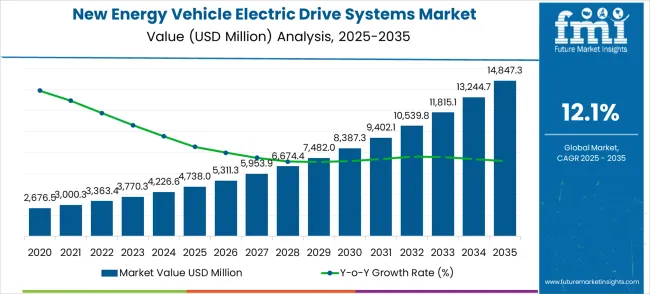
Between 2030 and 2035, the market is expected to generate approximately USD 4,159 million in new revenue, driven by broader market penetration in emerging markets and upgrades to higher-performance drive systems in existing fleets. Innovations in motor efficiency, integrated power electronics, and lightweight system design further reinforce growth. Evaluating growth in half-decade blocks highlights how early adoption creates a foundation for accelerated expansion in the later phase, while technological advancements and regional market development strengthen later-stage growth. This approach allows manufacturers and investors to optimize production, R&D, and deployment strategies to capture maximum value throughout the decade.
The NEV electric drive systems market is divided across passenger electric vehicles (42%), commercial electric vehicles including buses and trucks (28%), two-wheelers and three-wheelers (15%), off-road and construction NEVs (9%), and specialty applications such as electric racing and high-performance vehicles (6%). Passenger EVs lead adoption due to the growing shift toward cleaner mobility and government incentives for emission reduction. Commercial EVs benefit from lower operational costs and energy-efficient fleets. Two- and three-wheelers are expanding in urban transport, while off-road and construction NEVs rely on electric drive systems for performance in rugged environments. Specialty applications focus on high-efficiency, precision-controlled drive systems for performance optimization.
Key trends include high-torque, lightweight motors, integrated power electronics, and advanced thermal management solutions. Manufacturers are innovating with AI-enabled control systems, modular drive units, and the integration of regenerative braking. Rising EV adoption, government incentives, and urban electrification initiatives drive growth. Collaborations between drive system suppliers and NEV manufacturers enable the development of customized solutions that enhance efficiency, reliability, and performance, thereby supporting sustained global market expansion.
| Metric | Value |
|---|---|
| Market Value (2025) | USD 4,738.0 million |
| Market Forecast Value (2035) | USD 14,847.3 million |
| Market Forecast CAGR | 12.1% |
Market expansion is being supported by the rapid increase in electric vehicle production worldwide and the corresponding need for advanced powertrain systems that provide superior efficiency and operational performance. Modern electric vehicle applications rely on sophisticated drive technologies to ensure optimal vehicle performance including acceleration responsiveness, energy efficiency, and regenerative braking capability. Even minor efficiency losses can require comprehensive vehicle design adjustments to maintain optimal range and performance standards.
The growing complexity of electric vehicle requirements and increasing demand for integrated powertrain solutions are driving demand for electric drive systems from certified manufacturers with appropriate engineering capabilities and automotive expertise. Automotive companies are increasingly requiring documented efficiency ratings and system reliability to maintain vehicle performance and regulatory compliance. Industry specifications and automotive standards are establishing standardized electrification procedures that require specialized drive technologies and validated control systems.
The market is segmented by product type, application, and region. By product type, the market is divided into integrated electric drive system and split electric drive system. Based on application, the market is categorized into passenger vehicles and commercial vehicles. Regionally, the market is divided into North America, Europe, East Asia, South Asia & Pacific, Latin America, and Middle East & Africa.
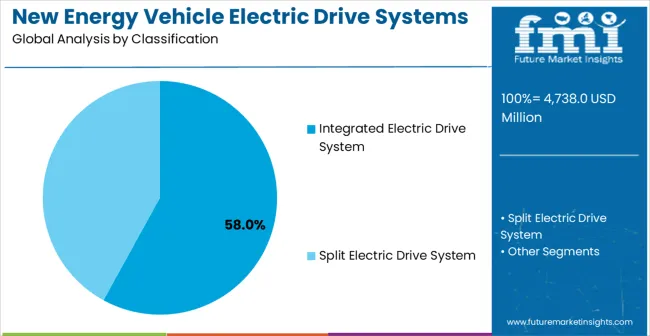
In 2025, the integrated electric drive system segment is projected to capture around 58% of the total market share, making it the leading product category. This dominance is largely driven by the widespread adoption of compact, all-in-one powertrain solutions that deliver superior packaging efficiency and system integration capabilities, catering to a wide variety of electric vehicle applications. The integrated drive system approach is particularly favored for its ability to provide optimized power delivery and thermal management while maintaining reduced vehicle weight and installation complexity, ensuring optimal vehicle performance.
Automotive manufacturers, electric vehicle startups, commercial fleet operators, and system integrators increasingly prefer this technology type, as it meets space constraints without compromising power output or operational efficiency. The availability of well-established integration technologies, along with comprehensive control software and thermal management systems from leading manufacturers, further reinforces the segment's market position.
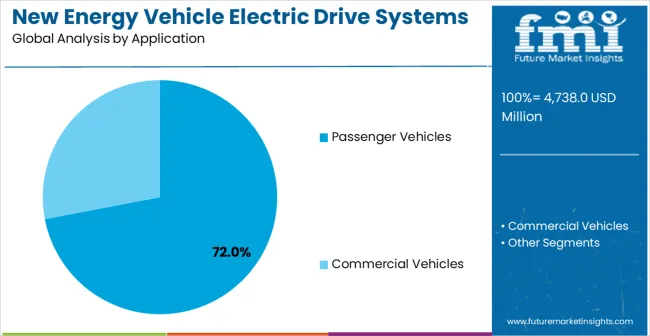
The passenger vehicle segment is expected to represent 72% of new energy vehicle electric drive system demand in 2025, highlighting its position as the most significant application sector. This dominance stems from the unique requirements of consumer automotive environments, where performance optimization and cost efficiency are critical to market adoption success. Passenger vehicle applications often feature demanding performance expectations that require advanced drive systems with proven reliability throughout diverse driving conditions. Electric drive systems are particularly well-suited to these environments due to their ability to deliver smooth acceleration and efficient operation effectively, even during varied urban and highway driving scenarios.
The segment also benefits from substantial investment within the automotive industry, where manufacturers are increasingly prioritizing vehicle electrification and consumer satisfaction as differentiators to ensure market competitiveness and regulatory compliance. With automotive companies investing in comprehensive electric vehicle portfolios and performance enhancement programs, electric drive systems provide essential solutions to maintain high-performance passenger vehicle operations. The growth of premium electric vehicle segments, coupled with increased focus on driving range optimization, ensures that passenger vehicles will remain the largest and most stable demand driver for electric drive systems in the forecast period.
The New Energy Vehicle Electric Drive Systems market is advancing rapidly due to increasing electric vehicle adoption worldwide and growing recognition of integrated drive system advantages over distributed component architectures. The market faces challenges including complex thermal management requirements for high-power applications, need for specialized manufacturing equipment for precision motor production, and varying electric vehicle adoption rates across different geographic regions. Technology advancement efforts and efficiency improvement programs continue to influence system development and market adoption patterns.
The growing development of advanced permanent magnet and synchronous motor systems is enabling superior power density output with improved efficiency characteristics and enhanced performance capabilities. Enhanced motor technologies and optimized magnetic designs provide superior vehicle performance while maintaining thermal management requirements. These technologies are particularly valuable for automotive manufacturers who require reliable powertrain performance that can support extensive driving operations with consistent results.
Modern electric drive system manufacturers are incorporating advanced digital control algorithms and AI-enhanced optimization improvements that enhance power delivery and energy management efficiency. Integration of predictive control systems and optimized battery management enables superior vehicle performance and comprehensive energy optimization capabilities. Advanced smart control features support operations in diverse driving environments while meeting various efficiency requirements and performance specifications.
The New Energy Vehicle Electric Drive Systems market is entering a new phase of explosive growth, driven by demand for vehicle electrification, battery technology advancement, and evolving sustainability and performance standards. By 2035, these pathways together can unlock USD 4,000-5,000 million in incremental revenue opportunities beyond baseline growth.
Pathway A -- Passenger Vehicle Electrification Leadership Passenger vehicles represent the largest opportunity due to mass market adoption and performance requirements. Advanced integrated drive systems for consumer electric vehicles offer premium positioning. Opportunity pool: USD 1,500-1,800 million.
Pathway B -- Commercial Vehicle Fleet Electrification Commercial vehicle electrification presents significant opportunities due to fleet operator cost optimization and regulatory compliance. Heavy-duty electric drive systems for logistics and transportation applications drive specialized segment growth. Opportunity pool: USD 1,000-1,200 million.
Pathway C -- Integrated System Technology Leadership All-in-one powertrain solutions present expanding opportunities due to packaging and efficiency advantages. Advanced integrated systems with embedded power electronics can capture premium market segments. Opportunity pool: USD 800-1,000 million.
Pathway D -- Emerging Market Vehicle Electrification Asia-Pacific, Latin America, and emerging markets present massive growth potential due to accelerating electric vehicle adoption. Local partnerships and cost-optimized solutions will drive rapid adoption. Opportunity pool: USD 600-800 million.
Pathway E -- High-Performance Vehicle Applications Sports and luxury electric vehicles offer secondary growth opportunities. Specialized high-power drive systems for performance applications provide premium market segments. Opportunity pool: USD 400-600 million.
Pathway F -- Autonomous Vehicle Integration Self-driving vehicle applications represent emerging opportunities. Drive systems optimized for autonomous operation with enhanced reliability and redundancy features capture future mobility market expansion. Opportunity pool: USD 300-500 million.
Pathway G -- Wireless Power Transfer Integration Dynamic charging and wireless power transfer capabilities create opportunities for next-generation drive systems. Integration with wireless charging infrastructure provides competitive differentiation. Opportunity pool: USD 200-300 million.
Pathway H -- Aftermarket and Retrofit Solutions Conversion systems and aftermarket electric drive solutions offer niche opportunities for existing vehicle fleet electrification and performance enhancement applications. Opportunity pool: USD 100-200 million.
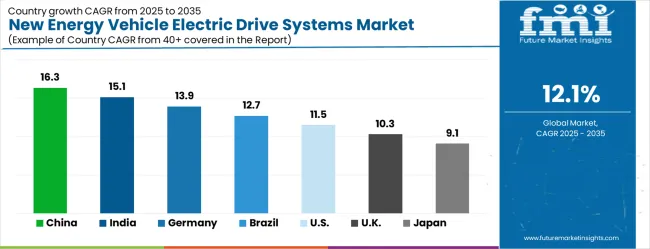
| Country | CAGR (2025-2035) |
|---|---|
| China | 16.3% |
| India | 15.1% |
| Germany | 13.9% |
| Brazil | 12.7% |
| United States | 11.5% |
| United Kingdom | 10.3% |
| Japan | 9.1% |
The new energy vehicle electric drive systems market is experiencing robust growth, with China leading at a 16.3% CAGR through 2035, driven by massive electric vehicle production scaling and increasing adoption of advanced powertrain technologies in automotive manufacturing. India follows at 15.1%, supported by ambitious electric mobility policies and growing focus on domestic electric vehicle production capabilities. Germany grows rapidly at 13.9%, integrating advanced electric drive technologies into its established automotive manufacturing infrastructure and premium vehicle segments. Brazil records 12.7%, prioritizing automotive industry electrification and green mobility enhancement programs. The United States shows strong growth at 11.5%, focusing on electric vehicle market expansion and powertrain innovation advancement. The United Kingdom demonstrates robust progress at 10.3%, maintaining established automotive technology applications while expanding electric vehicle production. Japan records 9.1% growth, concentrating on precision motor development and hybrid vehicle technology optimization.
The report covers an in-depth analysis of 40+ countries, Top-performing countries are highlighted below.
The new energy vehicle electric drive systems in China is projected to exhibit the highest growth rate with a CAGR of 16.3% through 2035, driven by the world's largest electric vehicle manufacturing base and increasing demand for advanced powertrain systems in automotive production. The country's dominant position in global electric vehicle production and expanding battery manufacturing capabilities are creating unprecedented demand for sophisticated electric drive solutions. Major automotive and component manufacturers are establishing comprehensive supply chains to support the increasing requirements of electric vehicle OEMs and system integrators across all major industrial centers.
Government electric vehicle development initiatives are supporting establishment of comprehensive electric mobility ecosystems and advanced automotive manufacturing, driving demand for electric drive technologies throughout major automotive clusters. New energy vehicle sector policies are facilitating adoption of advanced powertrain technologies that enhance vehicle performance and enable domestic technology leadership across automotive networks.
The new energy vehicle electric drive market in India is expanding at a 15.1% CAGR, supported by comprehensive electric mobility initiatives and growing focus on domestic automotive electrification capabilities. The country's ambitious electric vehicle targets and rising local manufacturing requirements are driving demand for sophisticated electric drive solutions. Automotive manufacturers and component suppliers are rapidly implementing advanced powertrain systems to meet government mandates and capture growing market opportunities.
Electric mobility sector growth and domestic manufacturing programs are creating unprecedented opportunities for component suppliers that can support diverse vehicle requirements and cost specifications. Professional development and technology transfer programs are building technical expertise among local engineering teams, enabling effective utilization of electric drive technology that meets automotive quality standards and performance requirements.
The new energy vehicle electric drive systems market in Germany is projected to grow at a 13.9% CAGR, supported by the country's focus on premium automotive quality and advanced electric powertrain technology adoption. German automotive manufacturers are implementing sophisticated electric drive systems that meet stringent performance requirements and quality specifications. The market is characterized by focus on high-performance applications, technological excellence, and compliance with comprehensive automotive standards.
Premium automotive industry investments are prioritizing advanced electric drive technologies that demonstrate superior performance and reliability while enabling luxury vehicle electrification and performance optimization. Professional certification programs are ensuring comprehensive technical expertise among automotive engineers, enabling specialized drive system development capabilities that support diverse premium vehicle applications and performance requirements.
The market for new energy vehicle electric drive systems in Brazil is growing at a 12.7% CAGR, driven by increasing automotive industry electrification and growing recognition of electric powertrain advantages in vehicle manufacturing. The country's expanding automotive electrification programs are gradually integrating sophisticated drive technologies to enhance vehicle capabilities and meet sustainability targets. Automotive manufacturers and suppliers are investing in electric drive solutions to address evolving regulatory standards and market requirements.
Automotive electrification programs are facilitating adoption of advanced electric drive technologies that support comprehensive vehicle electrification capabilities across automotive manufacturing and assembly regions. Professional development programs are enhancing technical capabilities among automotive professionals, enabling effective drive system utilization that meets evolving automotive standards and sustainability requirements.
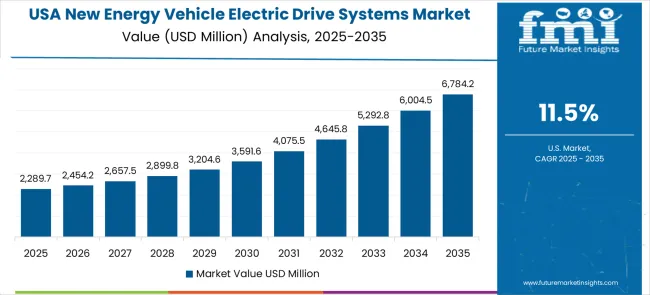
Demand for new energy vehicle electric drive systems in the USA is expanding at an 11.5% CAGR, driven by established automotive leadership and growing prioritizes on electric vehicle market expansion and technology innovation. Large automotive manufacturers and technology companies are implementing comprehensive electric drive capabilities to serve diverse vehicle segments and market requirements. The market benefits from established automotive ecosystems and advanced research programs that support cutting-edge electric powertrain applications.
Electric vehicle market leadership is enabling standardized drive system workflows across multiple vehicle platforms, providing consistent performance quality and comprehensive electrification coverage throughout national markets. Professional development and certification programs are building specialized technical expertise among automotive professionals, enabling effective drive system utilization that supports evolving electric vehicle market requirements.
Demand for new energy vehicle electric drive systems in the UK is projected to grow at a 10.3% CAGR, supported by established automotive sectors and growing prioritizes on electric vehicle transition and green mobility development. British automotive manufacturers and technology providers are implementing electric drive systems that meet industry quality standards and regulatory requirements. The market benefits from established automotive infrastructure and comprehensive research programs for electric powertrain technologies.
Automotive transition investments are prioritizing advanced electric drive technologies that support diverse vehicle applications while maintaining established quality and sustainability standards. Professional development programs are building technical expertise among automotive personnel, enabling specialized drive system operation capabilities that meet evolving electrification requirements and quality standards.
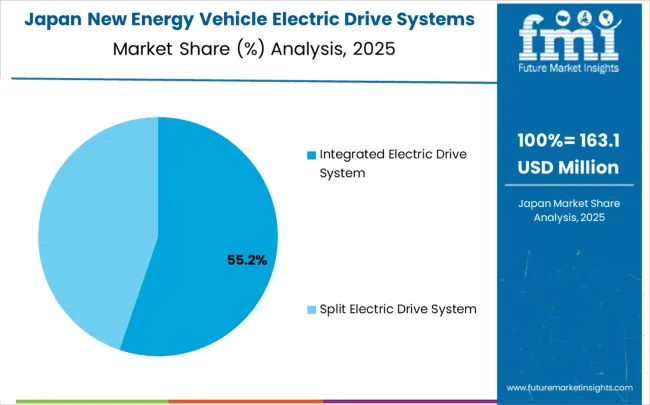
The new energy vehicle electric drive market in Japan is growing at a 9.1% CAGR, driven by the country's focus on precision automotive technology innovation and advanced hybrid vehicle applications. Japanese automotive companies and technology manufacturers are implementing sophisticated electric drive systems that demonstrate superior precision and operational efficiency. The market is characterized by focus on technological excellence, quality assurance, and integration with established automotive manufacturing workflows.
Precision automotive industry investments are prioritizing innovative electric drive solutions that combine advanced motor technology with precision engineering while maintaining Japanese quality and reliability standards. Professional development programs are ensuring comprehensive technical expertise among automotive operators, enabling specialized drive system capabilities that support diverse vehicle applications and quality requirements.
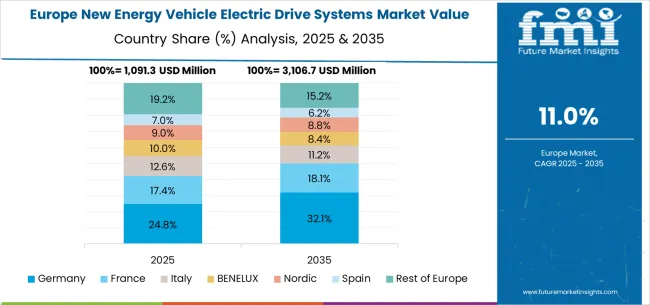
The new energy vehicle electric drive systems market in Europe is forecast to expand from USD 1,138.1 million in 2025 to USD 3,282.4 million by 2035, registering a CAGR of 11.2%. Germany will remain the largest market, holding 34.0% share in 2025, rising to 35.0% by 2035, supported by strong automotive manufacturing infrastructure and premium electric vehicle development. The United Kingdom follows, maintaining 19.5% share from 2025 to 2035, driven by automotive electrification initiatives and sustainable mobility programs. France is expected to grow from 16.0% to 16.5%, reflecting increased electric vehicle investment and automotive industry transformation.
Italy maintains growth at around 13.0% to 13.5%, supported by automotive sector electrification and component manufacturing expansion, while Spain grows from 8.5% to 9.0% with expanding electric vehicle production and sustainable transportation initiatives. Nordic markets rise from 6.0% to 6.5%, while the remainder of Europe hovers near 3.0%-0.5%, balancing emerging Eastern European automotive electrification growth against established Western markets.
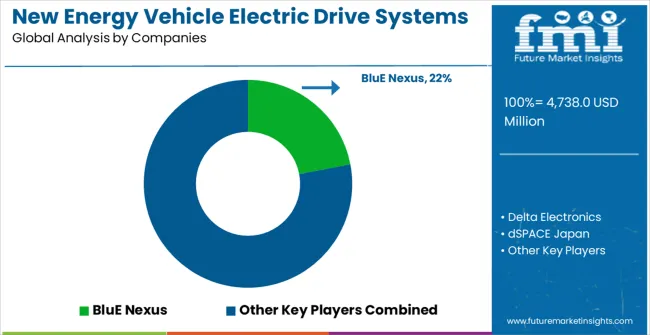
The New Energy Vehicle Electric Drive Systems market is defined by intense competition among specialized automotive component manufacturers, powertrain technology providers, and electric vehicle system integrators. Companies are investing in advanced motor technology development, power electronics optimization, system integration improvements, and comprehensive powertrain capabilities to deliver high-performance, efficient, and reliable electric drive solutions. Strategic partnerships, technological innovation, and market expansion are central to strengthening product portfolios and market presence.
BluE Nexus offers comprehensive electric drive system solutions with established automotive expertise and advanced integrated powertrain technologies optimized for passenger and commercial vehicle applications. Delta Electronics provides specialized power electronics and motor control systems with focus on high-efficiency applications and industrial-grade reliability. dSPACE Japan delivers advanced control and testing solutions with focus on electric powertrain development and validation capabilities. JATCO specializes in automotive transmission technologies with integrated electric drive solutions.
MHHO Electric offers precision electric motor systems with comprehensive power density optimization and thermal management capabilities. ZF provides established automotive component technologies with advanced electric drive integration and system reliability. Nissan delivers proven electric vehicle experience with integrated powertrain development and mass production capabilities. Bosch, MAHLE, GKN, Continental, Schaeffler, BorgWarner, Valeo, Denso, Hitachi Astemo, and Magna offer specialized manufacturing expertise, component reliability, and comprehensive product development across global and regional market segments.
| Item | Value |
|---|---|
| Quantitative Units | USD 4,738.0 million |
| Product Type | Integrated Electric Drive System, Split Electric Drive System |
| Application | Passenger Vehicles, Commercial Vehicles |
| Regions Covered | North America, Europe, East Asia, South Asia & Pacific, Latin America, Middle East & Africa |
| Country Covered | China, India, Germany, Brazil, United States, United Kingdom, Japan, and 40+ countries |
| Key Companies Profiled | BluE Nexus, Delta Electronics, dSPACE Japan, JATCO, MHHO Electric, ZF, Nissan, HASCO, JEE, SHedrive, SonnePower, Nanjing AE System Technology, Bosch, MAHLE, GKN, and others |
| Additional Attributes | Dollar sales by product type and application segment, regional demand trends across major markets, competitive landscape with established automotive manufacturers and emerging technology providers, customer preferences for different drive system configurations and efficiency levels, integration with vehicle platforms and battery systems, innovations in motor efficiency and power electronics technologies, and adoption of smart control features with enhanced performance capabilities for improved electric vehicle workflows. |
The global new energy vehicle electric drive systems market is estimated to be valued at USD 4,738.0 million in 2025.
The market size for the new energy vehicle electric drive systems market is projected to reach USD 14,847.3 million by 2035.
The new energy vehicle electric drive systems market is expected to grow at a 12.1% CAGR between 2025 and 2035.
The key product types in new energy vehicle electric drive systems market are integrated electric drive system and split electric drive system.
In terms of application, passenger vehicles segment to command 72.0% share in the new energy vehicle electric drive systems market in 2025.






Our Research Products

The "Full Research Suite" delivers actionable market intel, deep dives on markets or technologies, so clients act faster, cut risk, and unlock growth.

The Leaderboard benchmarks and ranks top vendors, classifying them as Established Leaders, Leading Challengers, or Disruptors & Challengers.

Locates where complements amplify value and substitutes erode it, forecasting net impact by horizon

We deliver granular, decision-grade intel: market sizing, 5-year forecasts, pricing, adoption, usage, revenue, and operational KPIs—plus competitor tracking, regulation, and value chains—across 60 countries broadly.

Spot the shifts before they hit your P&L. We track inflection points, adoption curves, pricing moves, and ecosystem plays to show where demand is heading, why it is changing, and what to do next across high-growth markets and disruptive tech

Real-time reads of user behavior. We track shifting priorities, perceptions of today’s and next-gen services, and provider experience, then pace how fast tech moves from trial to adoption, blending buyer, consumer, and channel inputs with social signals (#WhySwitch, #UX).

Partner with our analyst team to build a custom report designed around your business priorities. From analysing market trends to assessing competitors or crafting bespoke datasets, we tailor insights to your needs.
Supplier Intelligence
Discovery & Profiling
Capacity & Footprint
Performance & Risk
Compliance & Governance
Commercial Readiness
Who Supplies Whom
Scorecards & Shortlists
Playbooks & Docs
Category Intelligence
Definition & Scope
Demand & Use Cases
Cost Drivers
Market Structure
Supply Chain Map
Trade & Policy
Operating Norms
Deliverables
Buyer Intelligence
Account Basics
Spend & Scope
Procurement Model
Vendor Requirements
Terms & Policies
Entry Strategy
Pain Points & Triggers
Outputs
Pricing Analysis
Benchmarks
Trends
Should-Cost
Indexation
Landed Cost
Commercial Terms
Deliverables
Brand Analysis
Positioning & Value Prop
Share & Presence
Customer Evidence
Go-to-Market
Digital & Reputation
Compliance & Trust
KPIs & Gaps
Outputs
Full Research Suite comprises of:
Market outlook & trends analysis
Interviews & case studies
Strategic recommendations
Vendor profiles & capabilities analysis
5-year forecasts
8 regions and 60+ country-level data splits
Market segment data splits
12 months of continuous data updates
DELIVERED AS:
PDF EXCEL ONLINE
Newborn Identification Tag Market Size and Share Forecast Outlook 2025 to 2035
Newborn Jaundice Treatment Market Size and Share Forecast Outlook 2025 to 2035
Newborn Name Tag Market Size and Share Forecast Outlook 2025 to 2035
New Zealand Sustainable Tourism Market Size and Share Forecast Outlook 2025 to 2035
New-born Screening Equipment Market - Growth & Demand 2025 to 2035
New Zealand Sports Tourism Market Analysis - Size, Share, and Forecast 2025 to 2035
New Born Eye Imaging Systems Market Size and Share Forecast Outlook 2025 to 2035
Renewable Heating Fuels Market Size and Share Forecast Outlook 2025 to 2035
Renewable Isocyanate Market Forecast and Outlook 2025 to 2035
Renewable Naphtha Market Size and Share Forecast Outlook 2025 to 2035
Renewable Biopolymer Cosmetics Market Size and Share Forecast Outlook 2025 to 2035
Renewable Based Shunt Reactor Market Size and Share Forecast Outlook 2025 to 2035
Renewable Polyethylene Market Size and Share Forecast Outlook 2025 to 2035
Renewable Methanol Market Growth - Trends & Forecast 2025 to 2035
Renewable Solvents Market
Renewable Energy Certificate Market Size and Share Forecast Outlook 2025 to 2035
Renewable Energy Contactor Market Size and Share Forecast Outlook 2025 to 2035
Renewables Energy Consulting Service Market Size and Share Forecast Outlook 2025 to 2035
Cellular Renewal Actives Market Analysis - Size and Share Forecast Outlook 2025 to 2035
Fossil Fuel New Energy Generation Market Size and Share Forecast Outlook 2025 to 2035

Thank you!
You will receive an email from our Business Development Manager. Please be sure to check your SPAM/JUNK folder too.
Chat With
MaRIA